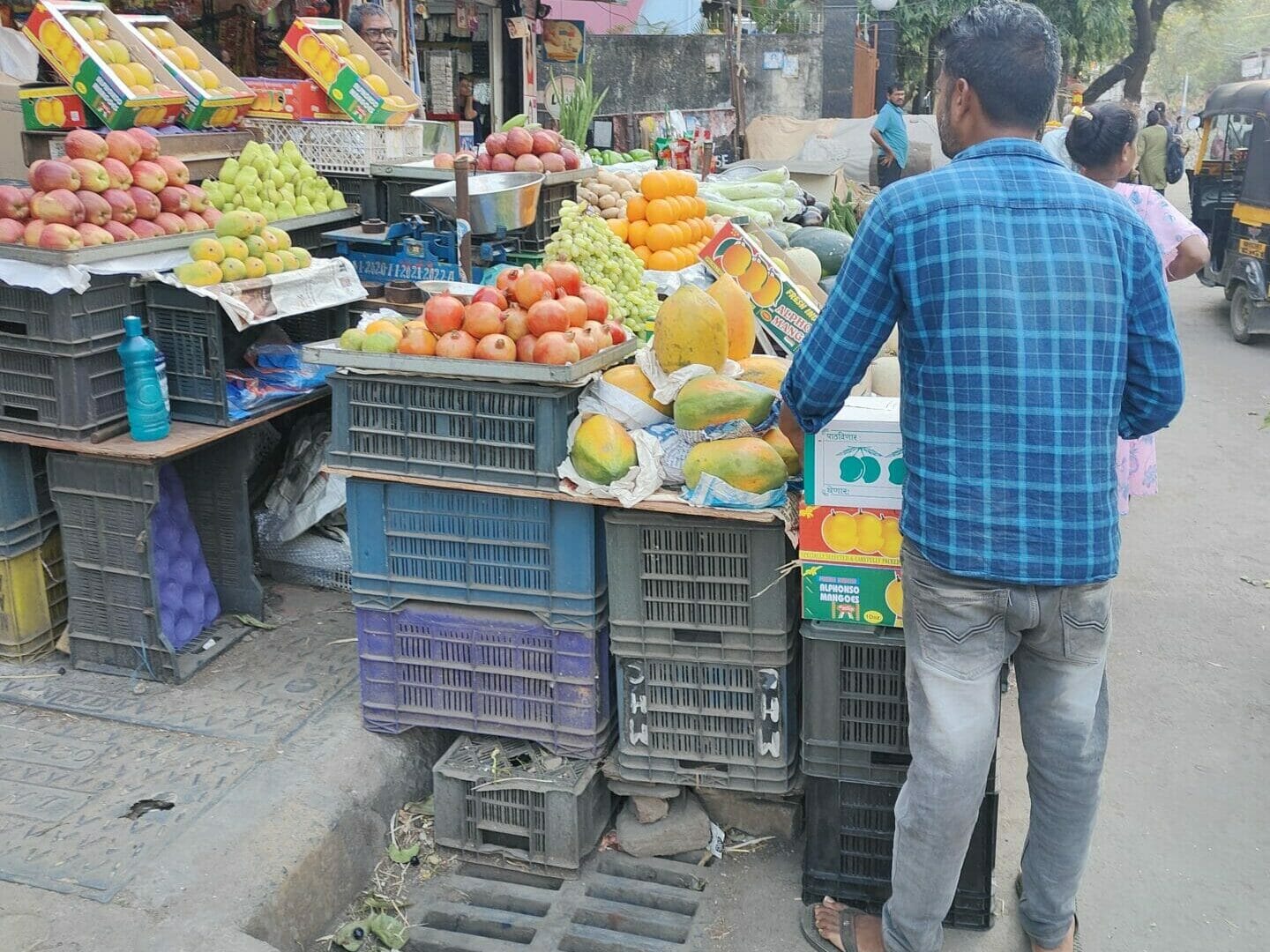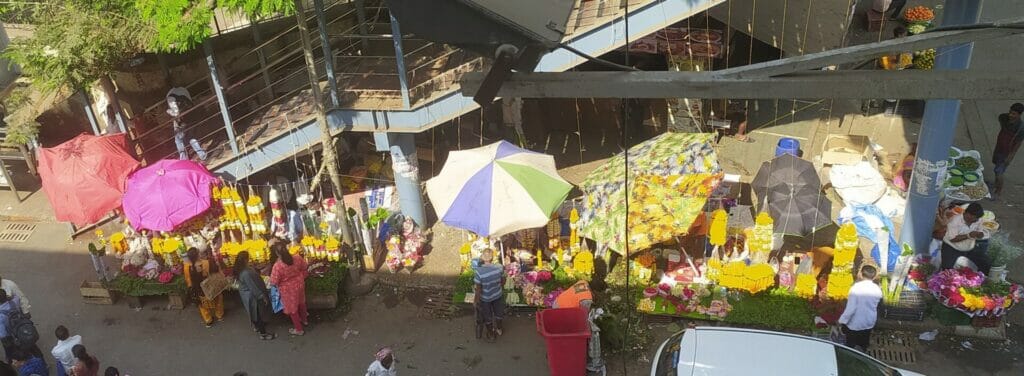Ramesh, a vegetable vendor in Mumbai is a resident of Uttar Pradesh where his family lives while he is here in the city, earning his living. For over a decade, Ramesh works for 10 to 12 hours a day, on the streets selling perishable vegetables and fruits. Working in the adverse climatic conditions of heat, monsoon and mild winter is part of his occupation. “Garmi ka toh kuch kar nahi sakte, paise toh kamaane hi hai,” (We cannot do much about the heat when the question is about our livelihood)” he says with a smile, when asked about the current heatwave in the city.
Street vendors: a huge workforce
Around six to ten million street vendors are estimated to work in India comprising of 14% of the country’s workforce. The 2011 Census shows that the Mumbai city’s population is around 1.2 crore and of this growing population, 65% work in the unorganised sector. It is estimated that 2.5% of the city’s population comprises of street vendors. If one goes by this measure, at least 2,50,000 people are street vendors thus constituting a large section of the urban workforce.
According to studies, the poorer sections of the society procure their basic necessities mainly through street vendors. In many ways, one section of urban poor (in this case street vendors) provide goods to the other section at relatively lower rates. Moreover, the middle class also purchases extensively from the street vendors or roadside stalls.
Read more: Mumbai hawkers in limbo: Government offers loans but continues eviction drives
Though hawking is legal since the The Street Vendor’s (Protection of Livelihood and Regulation of Street Vending) Act, 2014 came into force, the process of issuing of licenses has been slow. As per records, only about 15,000 hawkers have licenses issued by the Brihanmumbai Municipal Corporation’s Town Vending Committee (TVC), responsible for declaring appropriate areas as street vending zones and issuing licenses.
On many instances, the BMC conducts eviction drives to clear the streets and takes away their carts and wares. They also lack appropriate linkages to social security, welfare and assistance schemes provided by the government as it is an unorganised sector.
Prior to the onset of the gig platforms such as Big Basket, Swiggy, Instamart , Zepto, Dunzo, most people would depend on street vendors for their daily supplies ranging from fruits, flowers, vegetables to stationary, shoes, daily wear. Since the pandemic, gig platforms have been the main go-to option for people. Consequently, the business of street vendors has been impacted.
To make matters worse, over the past few years, climate change – specifically urban heat and increasing pollution – has impacted their health and livelihood both.
A day in the life of a street vendor
At about 4:30 am, every day, Kumar and Mahesh, who sell vegetables and fruits at the Santacruz Market, go to the local APMC market to source their goods. They start setting their stalls up by 7:00 am in the markets at the local market. Sunny, another flower vendor said that he opens his shop at 6:00 am. Before that, he goes to the Dadar wholesale flower market and purchases flowers.
Most of the street vendors reside 5km-10km away from their working area and use local transport such as trains or buses for commuting. They said they work for about 12 to 14 hours on an average.

They spoke about being exposed to the gruelling working conditions of harsh sunlight or heavy rainfall. Limited access to toilets and drinking water facilities is a major challenge. “Humein 200 rupaye dene hote hai har mahine, BMC ka banaya hua toilet ka istamaal karne ke liye.” (We have to pay Rs. pay Rs. 200/- per month for using the toilet facilities), says Narayan, a fruit vendor, at the Kalina Market.
There is no drinking water facility around the vendors and all of them bring water bottles from their homes. In case, the water gets over then they have to purchase water bottles. Most of the vendors have a huge umbrella overhead for shade. Sometimes they cover their stalls with a plastic sheet for some relief.
Very few among these vendors were women and they said women worked as domestic helpers or managed household chores.
Worsening health as heat increases
“In Delhi 65% of street vendors complained about breathing difficulty and 70% complained of eye irritation, thereby indicating that the major brunt of pollution is faced by them,” said Sreedhar Ramumurthi, Earth Scientist at Environics Trust. In Mumbai too, the heat severely impacts their respiratory health, exposing them to hazards of heat stroke.
In the past few weeks, Mumbai witnessed extreme climatic changes with scorching heat on one hand to untimely rain showers on the other leading to people falling sick. However, the street vendors say they cannot even take a day off despite the strain on their physical and mental health, since it is a matter of their livelihood.
Read more: Heat mitigation on the streets of Mumbai
Moreover, there is a constant risk of the vegetables, fruits and flowers getting spoilt because of heat and humidity. The vendors constantly sprinkle fresh water to ensure the perishables remain fresh and last longer.

Climate change, construction and urban heat
A study by the Researchers Faculty of Natural Sciences, Jamia Millia Islamia stated that Mumbai has witnessed a 2-degree Celsius average rise in temperature in the past 27 years (1991-2018) and the built-up area in the city has risen by 66% in the same period. Another study published in Springer revealed that Mumbai’s development has led to a 42.5% decline in its green cover. This paves way for higher urban temperatures.
“Mumbai being an urban centre, with a large population, increasing concretisation, reduced tree cover, and lots of vehicular emissions, will no doubt experience higher temperatures than other stations in the region,” says DS Pai, Director, Institute of Climate Change Studies.
The increase in higher temperatures has a direct impact on citizens whose livelihood requires them to be out of their homes for the better part of the day, such as hawkers or labourers. It is likely to get worse, with the cutting down of trees in Aarey Forest. Experts say heatwaves and increasing humidity are set to become the norm in Mumbai.
Mitigating climate change together
The former Maharashtra Chief Minister Uddhav Thackeray took an active step and launched the Mumbai Climate Action Plan (MCAP). It was essentially designed to reduce emissions and meet the climate goals outlined in the Paris Agreement to limit global warming to 1.5oC. The aim is to eventually become a climate resilient city.
The civic body has collaborated with the World Resource Institute (WRI) and the plan will focus on sustainable solid waste management, urban greening, and biodiversity, flood and water resources management, efficient energy building, clean air quality and sustainable mobility.
The policy will be framed keeping the larger picture of Mumbai. However, it does not essay out the impact it will have on specific individuals – in this case, street vendors or daily wage labourers.
Can we beat the heat?
Vendors say that small steps will help them greatly. Local level measures such as providing umbrellas, installing drinking water units, providing washroom facilities can mitigate their distress to a large extent.
These citizens of Mumbai are not very bothered by the heat as they know that they can do nothing about. Ultimately, it is about earning their income and have adapted to the current climatic conditions.
The onus now lies on elected representatives who can ensure better working conditions and reduce the impact of heat on the workforce that toils with no break.
Also read:
- What are the demands of Mumbai’s street vendors?
- Interview: How to protect yourself against extreme heat in Mumbai
- Heat, dust and other challenges facing construction workers in Mumbai